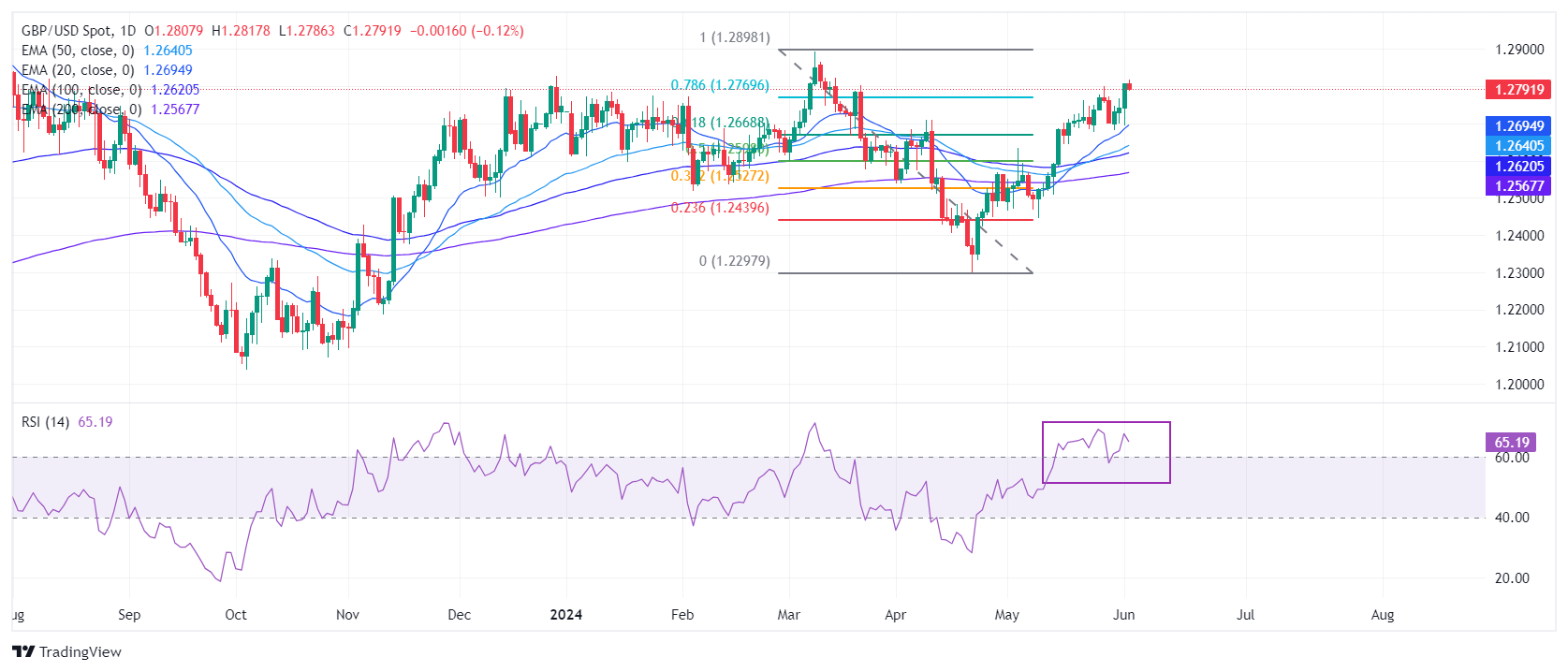- The Pound Sterling faces selling pressure near 1.2800 against the USD even though traders raised Fed rate-cut bets for September.
- A weak US factory PMI report boosts the possibility of the Fed pivoting to rate cuts.
- UK’s persistent service inflation remains a major concern for BoE policymakers.
The Pound Sterling (GBP) corrects from the round-level resistance of 1.2800 against the US Dollar in Tuesday’s New York session. The GBP/USD pair falls after posting a fresh two-month high as the US Dollar (USD) recovers. The US Dollar rebounds as market sentiment turns cautious ahead of the United States Nonfarm Payrolls (NFP) data for May, which will be published on Friday. The labor market will provide fresh cues about when the Federal Reserve (Fed) will start reducing interest rates.
Currently, there is a firm speculation that the Fed will begin lowering borrowing rates from the September meeting. Market expectations for the Fed returning to policy normalisation in September strengthened after the weaker-than-expected United States (US) ISM Manufacturing PMI report for May indicated that the growth outlook of the world’s largest economy appears to be losing momentum. According to the PMI report, US manufacturing activity contracted for a second straight month as “demand remains elusive as companies demonstrate an unwillingness to invest due to current monetary policy and other conditions.”
The Manufacturing PMI, which gauges the health of factory activity, came in at 48.7, lower than the consensus of 49.6 and the former release of 49.2. The report also indicated a bleak demand environment and easing inflation prospects. The New Orders Index, which reflects the demand outlook, declined to 45.4 from the prior reading of 49.1. The Prices Paid Index, which gauges chances in input prices, dropped to 57.0 from the consensus of 60.0 and the prior reading of 60.9. Decelerating input price growth results in a slower increase in selling prices, which eases fears of inflation remaining persistent.
Daily digest market movers: Pound Sterling corrects as US Dollar rebounds
- The Pound Sterling weakens against the US Dollar as the latter steadies in Tuesday’s European session after Monday’s sell-off. The US Dollar Index (DXY), which tracks the Greenback’s value against six major currencies, is up from an almost two-month low near 104.00. The near-term outlook of the GBP/USD pair remains uncertain as traders increasingly price in that the Fed will lower interest rates in September.
- The CME FedWatch tool shows that traders see a 60% chance for interest rates declining from their current levels in September. The probability has improved significantly from 45.8% registered a week ago. The market speculation for Fed rate cuts is expected to remain volatile this week as investors gear up for major economic data releases such as the ISM Services PMI and Nonfarm Payrolls (NFP) data for May, which will be published on Wednesday and Friday, respectively.
- Meanwhile, the US Bureau of Labor Statistics (BLS) has reported weak JOLTS Job Openings data for April. The agency reported that US employers posted 8.06 million jobs, lower than the estimates of 8.34 million and the prior reading of 8.49 million. Lower job postings suggest that the labor market is losing strength.
- In the United Kingdom (UK), market speculation for Bank of England (BoE) rate cuts isn’t likely to move much Pound Sterling due to the absence of top-tier economic events and the fact that BoE officials aren’t speaking until after the upcoming elections. Currently, financial markets expect that the BoE will start reducing interest rates in the August meeting. UK’s annual headline Consumer Price Index (CPI) has come down significantly to 2.3% while persistent service inflation is still a major concern for BoE policymakers.
Technical Analysis: Pound Sterling aims stabilization above 78.6% Fibo retracement
The Pound Sterling falls from the round-level resistance of 1.2800 against the US Dollar. The GBP/USD pair aims to sustain above the 78.6% Fibonacci retracement support at 1.2770 (plotted from the March 8 high of 1.2900 to the April 22 low at 1.2300).
The Cable is expected to remain in the bullish trajectory as all short-to-long-term Exponential Moving Averages (EMAs) are sloping higher, indicating a strong uptrend.
The 14-period Relative Strength Index (RSI) has shifted into the 40.00-60.00 range, suggesting that the momentum has leaned toward the upside.
Economic Indicator
JOLTS Job Openings
JOLTS Job Openings is a survey done by the US Bureau of Labor Statistics to help measure job vacancies. It collects data from employers including retailers, manufacturers and different offices each month.
Read more.Last release: Tue Jun 04, 2024 14:00
Frequency: Monthly
Actual: 8.059M
Consensus: 8.34M
Previous: 8.488M
Source: US Bureau of Labor Statistics
Information on these pages contains forward-looking statements that involve risks and uncertainties. Markets and instruments profiled on this page are for informational purposes only and should not in any way come across as a recommendation to buy or sell in these assets. You should do your own thorough research before making any investment decisions. FXStreet does not in any way guarantee that this information is free from mistakes, errors, or material misstatements. It also does not guarantee that this information is of a timely nature. Investing in Open Markets involves a great deal of risk, including the loss of all or a portion of your investment, as well as emotional distress. All risks, losses and costs associated with investing, including total loss of principal, are your responsibility. The views and opinions expressed in this article are those of the authors and do not necessarily reflect the official policy or position of FXStreet nor its advertisers. The author will not be held responsible for information that is found at the end of links posted on this page.
If not otherwise explicitly mentioned in the body of the article, at the time of writing, the author has no position in any stock mentioned in this article and no business relationship with any company mentioned. The author has not received compensation for writing this article, other than from FXStreet.
FXStreet and the author do not provide personalized recommendations. The author makes no representations as to the accuracy, completeness, or suitability of this information. FXStreet and the author will not be liable for any errors, omissions or any losses, injuries or damages arising from this information and its display or use. Errors and omissions excepted.
The author and FXStreet are not registered investment advisors and nothing in this article is intended to be investment advice.
Recommended content
Editors’ Picks

Gold: Safe-haven demand lifts precious metal to record high above $3,200
Gold surged to a new record high above $3,200 despite a bearish opening last week. Safe-haven flows dominated the markets as the US-China trade conflict intensified. The technical outlook points to overbought conditions in the near term.

EUR/USD: Trade war chaos far from over, USD condemned
The EUR/USD pair jumped to 1.1473 on Friday, its highest since February 2022, amid escalating tensions between the United States and China, triggering a US Dollar sell-off.

GBP/USD trims gains, recedes to the 1.3050 zone
GBP/USD now gives away part of the earlier advance to fresh highs near 1.3150. Meanwhile, the US Dollar remains offered amid escalating China-US trade tensions, recession fears in the US, and softer-than-expected US Producer Price data.

Week ahead: ECB set to cut, BoC might pause as Trump U-turns on tariffs
ECB is expected to trim rates, but the BoC might pause this time. CPI data also in the spotlight; due in UK, Canada, New Zealand and Japan. Retail sales the main release in the United States. China GDP eyed as Beijing not spared by Trump.

Is a recession looming?
Wall Street skyrockets after Trump announces tariff delay. But gains remain limited as Trade War with China continues. Recession odds have eased, but investors remain fearful. The worst may not be over, deeper market wounds still possible.

The Best brokers to trade EUR/USD
SPONSORED Discover the top brokers for trading EUR/USD in 2025. Our list features brokers with competitive spreads, fast execution, and powerful platforms. Whether you're a beginner or an expert, find the right partner to navigate the dynamic Forex market.




